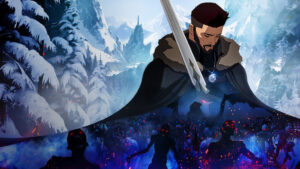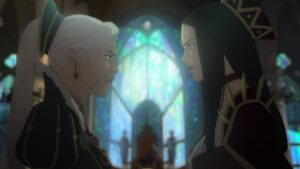With The Witcher franchise expanding exponentially across Netflix, I’m happy to report that the live-action series’ first spin-off is a resounding success. And as much as we all love Geralt of Rivia, the thrilling anime Nightmare Of The Wolf is sure to have fans baying for more adventures with Vesemir (voiced by Theo James), the charismatic monster-hunter who predates Geralt by almost a century – so it’s a good thing that season two of The Witcher, premiering later this year, will reunite audiences with Vesemir: albeit an older and wiser version of the character, portrayed in live-action by Kim Bodnia.

Or…well, it’s partly a good thing. Nightmare Of The Wolf is at its best when it’s doing its own thing and not trying too hard to connect back to the live-action series. Some crossover is inevitable because so many of the characters in this franchise are immortal, but Nightmare Of The Wolf tells such an interesting story, and with so many fascinating and complex characters, that at several points I totally forgot that it was a spin-off. The film stumbles a little in its final minutes when it starts feeling less like a stand-alone feature, and more like an extended prologue for The Witcher season two. I half-expected the words “Vesemir Will Return” to show up before the credits rolled.
But I do believe you could jump into Nightmare Of The Wolf without having watched The Witcher, and it would give you just enough worldbuilding to work with before starting the live-action series. Right up until those final minutes, the film is a wildly fun ride around The Continent that delivers on character development, action, and the kind of fantasy spectacle for which animation (and in this case, the high-quality anime of South Korea’s Studio Mir) is perfectly suited. Animation is simply capable of things that live-action isn’t, at least not on a limited CGI budget.
Take magic, for example. When The Witcher uses magic, it’s generally of the non-flashy variety – lots of wind-gusts, and conveniently invisible energy blasts and stuff. And it works, for the most part, in the grounded environment of the live-action series. But Nightmare Of The Wolf is straight-up fantasy, and the sky’s the limit when it comes to how much magic can be used, or how epic and visually stunning it can be. The anime shows off Witchers at the height of their ability, wielding magical spells and runes in battles with monsters who are capable of many of the same tricks, and mages who defy the very laws of physics. The third-act battle involving all three is a real treat.
And while The Witcher got a lot of criticism for not featuring all that many monsters in a show about monster-hunters, that’s not a complaint that can be had of Nightmare Of The Wolf. This film is chock-full of more demons, ghouls, werewolves, wraiths, and other beasts and creepy-crawlies in just an hour and a half than the live-action series could probably have afforded across eight episodes. Mind you, season two of The Witcher appears to have a great many monsters of its own, including a leshy like the one that Vesemir fights in the first few minutes of this film, so there’s no need to look down on the live-action series.
But of course, the real heart of this story is the human drama at play – because what are humans if not the worst monsters of them all, and the ones that Witchers are duty-bound to protect? That philosophical dilemma has always been the most interesting thing thematically about The Witcher franchise, but Nightmare Of The Wolf approaches the subject with more determination than the live-action series. At the time this prequel film takes place, Witchers and humans still interact regularly – and we can see the first rifts in that once-symbiotic relationship that by Geralt’s time have widened into a chasm of prejudice and distrust.

But while that’s all very interesting stuff, I feel that even Nightmare Of The Wolf cheats a little by retconning a pivotal moment in Vesemir’s backstory – the attack on the Witcher citadel of Kaer Morhen by an angry mob – to include monsters and mages. Perhaps it was meant to highlight the similarities between humans and monsters (and the ease with which they’ll side with their own enemies to gang up on somebody else), but it does draw the focus away from the conversation about humankind’s own capacity for monstrous acts of violence and hate.
On the flip-side, Nightmare Of The Wolf features one of the franchise’s most prominent human characters who is just that – all flesh and blood; no hidden superpowers. Her name is Lady Zerbst (voiced by Mary McDonnell), and she manages to steal the spotlight away from Vesemir in every one of her scenes. The spirit of kindness and generosity that’s motivated her for her entire life is like a breath of fresh air in the grimdark world of the Witchers where most people are driven by their worst instincts. She also has a really lovely romance, which is kind of a spoiler so I won’t give away anything except to say that it’s adorable.
Moving on from that, this film is built on plot twists. Installing powerful mages in every royal court across The Continent was always a great opportunity for political intrigue, and Nightmare Of The Wolf realizes some of that potential here, with an intricate tale of conspiracy and subterfuge. I can’t talk about any of that, however, so instead let’s discuss something that was revealed in the trailers: the return of Filavandrel (with Tom Canton reprising the role). The Elven king plays a larger role here than he did in The Witcher, and we get a new perspective on him and his motives that humanizes the enigmatic character a bit, but not so much that he loses any of his mystique.
And although this next point is technically a spoiler, it’s also so depressingly predictable that I felt I had to bring it up, because…seriously? The Witcher doesn’t have very many LGBTQ+ characters to begin with (and Ciri’s bisexuality has yet to be mentioned in the live-action series), so to introduce a cool new character, give them a few lines of dialogue confirming them as a queer Witcher (and if I’m not mistaken, the only queer male Witcher in the franchise), and then kill them off without even so much as a noble death in battle? That’s both cringeworthy and frustrating. We wanted bisexual Vesemir, Netflix; not a Bury Your Gays trope!

Things like that do hinder my enjoyment of Nightmare Of The Wolf, but the film is very well-made and serves as a great introduction to a character I think audiences will want to see much more of going forward. There’s plenty more story to tell through Vesemir’s eyes, and with The Witcher franchise already growing across multiple spin-offs, another anime film or miniseries couldn’t hurt, right? It’s so nice to meet a Witcher who actually…talks, and is emotionally honest, I’m not sure I’m ready to give him up just yet, or even trade him in for the broodier older version we’ll meet in live-action come December.
Rating: 8/10